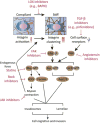Force Matters: Biomechanical Regulation of Cell Invasion and Migration in Disease
- PMID: 27056543
- PMCID: PMC4970516
- DOI: 10.1016/j.tcb.2016.03.007
Force Matters: Biomechanical Regulation of Cell Invasion and Migration in Disease
Abstract
Atherosclerosis, cancer, and various chronic fibrotic conditions are characterized by an increase in the migratory behavior of resident cells and the enhanced invasion of assorted exogenous cells across a stiffened extracellular matrix (ECM). This stiffened scaffold aberrantly engages cellular mechanosignaling networks in cells, which promotes the assembly of invadosomes and lamellae for cell invasion and migration. Accordingly, deciphering the conserved molecular mechanisms whereby matrix stiffness fosters invadosome and lamella formation could identify therapeutic targets to treat fibrotic conditions, and reducing ECM stiffness could ameliorate disease progression.
Keywords: cancer; cardiovascular disease; extracellular matrix stiffness; fibrosis; invasion; migration.
Published by Elsevier Ltd.
Figures



Similar articles
-
[Formation, organization and function of invadosomes in cell motility and tumor invasion].Med Sci (Paris). 2024 Jun-Jul;40(6-7):515-524. doi: 10.1051/medsci/2024080. Epub 2024 Jul 8. Med Sci (Paris). 2024. PMID: 38986096 Review. French.
-
Mechanotransduction pulls the strings of matrix degradation at invadosome.Matrix Biol. 2017 Jan;57-58:190-203. doi: 10.1016/j.matbio.2016.06.007. Epub 2016 Jul 5. Matrix Biol. 2017. PMID: 27392543 Review.
-
Significance of kinase activity in the dynamic invadosome.Eur J Cell Biol. 2016 Nov;95(11):483-492. doi: 10.1016/j.ejcb.2016.07.002. Epub 2016 Jul 19. Eur J Cell Biol. 2016. PMID: 27465307 Review.
-
Integration of biochemical and topographic cues for the formation and spatial distribution of invadosomes in nasopharyngeal epithelial cells.Acta Biomater. 2020 Jan 1;101:168-182. doi: 10.1016/j.actbio.2019.10.043. Epub 2019 Nov 2. Acta Biomater. 2020. PMID: 31683015
-
2D and 3D Matrices to Study Linear Invadosome Formation and Activity.J Vis Exp. 2017 Jun 2;(124):54911. doi: 10.3791/54911. J Vis Exp. 2017. PMID: 28605388 Free PMC article.
Cited by
-
Plasmin and Plasminogen System in the Tumor Microenvironment: Implications for Cancer Diagnosis, Prognosis, and Therapy.Cancers (Basel). 2021 Apr 12;13(8):1838. doi: 10.3390/cancers13081838. Cancers (Basel). 2021. PMID: 33921488 Free PMC article. Review.
-
Mechanically activated ion channel Piezo1 contributes to melanoma malignant progression through AKT/mTOR signaling.Cancer Biol Ther. 2022 Dec 31;23(1):336-347. doi: 10.1080/15384047.2022.2060015. Cancer Biol Ther. 2022. PMID: 36112948 Free PMC article.
-
Cannabidiol markedly alleviates skin and liver fibrosis.Front Pharmacol. 2022 Oct 19;13:981817. doi: 10.3389/fphar.2022.981817. eCollection 2022. Front Pharmacol. 2022. PMID: 36339540 Free PMC article.
-
Quantifying local stiffness and forces in soft biological tissues using droplet optical microcavities.Proc Natl Acad Sci U S A. 2024 Jan 23;121(4):e2314884121. doi: 10.1073/pnas.2314884121. Epub 2024 Jan 17. Proc Natl Acad Sci U S A. 2024. PMID: 38232279 Free PMC article.
-
Latest Advances in Targeting the Tumor Microenvironment for Tumor Suppression.Int J Mol Sci. 2019 Sep 23;20(19):4719. doi: 10.3390/ijms20194719. Int J Mol Sci. 2019. PMID: 31547627 Free PMC article. Review.
References
Publication types
MeSH terms
Grants and funding
LinkOut - more resources
Full Text Sources
Other Literature Sources

